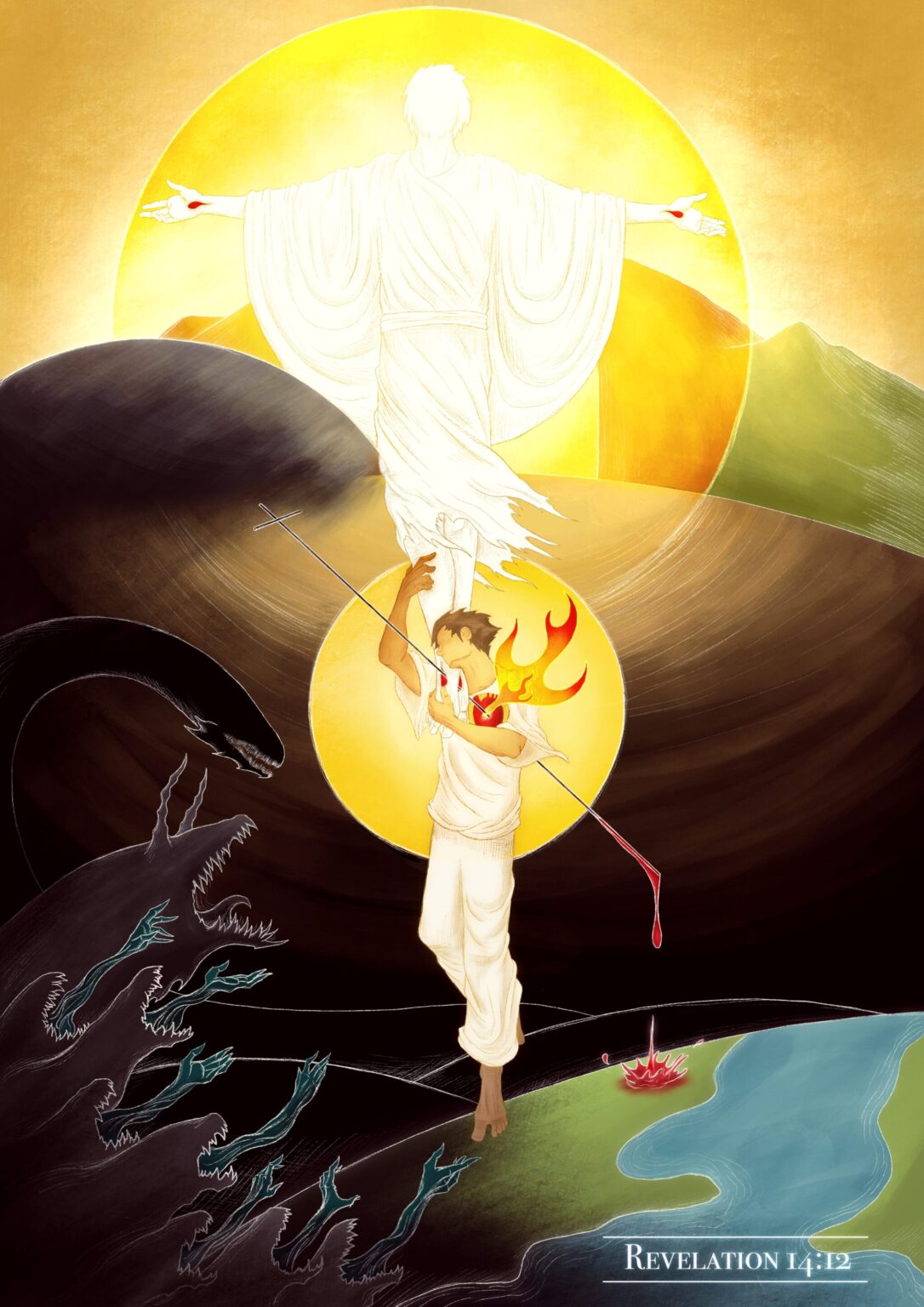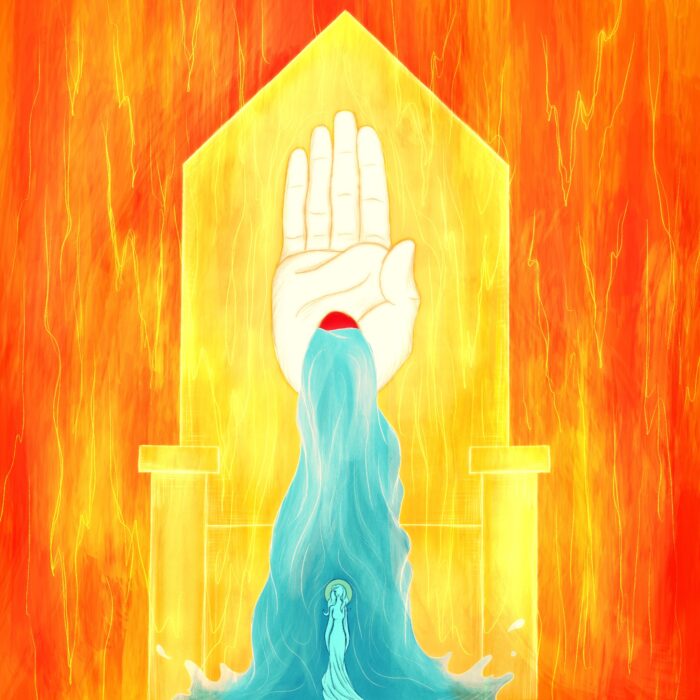
I was asked by a Full of Eyes supporter to create a picture that would help him remember to trust and obey the Lord in all that we do. So, my first order of business was to find a verse or passage that called us to both faith and obedience (arguably, every call to faith is a call to obedience and vis versa, but I wanted something explicit for this picture). I was reminded of Revelation 14:12 which says,
“Here is a call for the endurance of the saints, those who keep the commandments of God and their faith in Jesus.”
Now, whatever a person’s particular view of eschatology might be, I think all Christians can see in this text a universal call to the saints to hold fast to faith in and obedience to Christ (“trust and obey”), especially in the face of overwhelming opposition (13:11-18) and eternally significant stakes (14:9-11). The import of the passage is pretty clear, but everything turns on our understanding of what it means to “keep the commandments of God” and “faith in Jesus.” So I want to look at how I interpreted these two phrases and, in doing so, explain how they are represented in this image.
Faith – what does it mean to “keep faith in Jesus”?
What is “faith in Jesus”? I think one of the best places to go to answer this question is John 6:35ff. There Christ presents belief in Him as coming to Him and feeding on Him as True Food and True Drink (John 6:35, 47-50, 53ff, in fulfillment of Isaiah 55:1-3ff). The “feeding” imagery is both explicit and graphic. His point in saying that those who believe in Him must eat his flesh and drink His blood is to highlight the fact that the crucified Lord is the feast of faith. We are not called to believe in any other God, any other Savior, any other Lord than the one who offers up His body and pours out His blood on the cross….It is solely and precisely the Name / the Identity / the God revealed in this act that faith embraces. This, it seems, is why flesh and blood imagery is used. But why “eating” imagery?
The point here seems to be that there must be an affectional, soul-satisfaction with the crucified and risen Lord analogous to the physical, stomach-satisfaction that comes when we eat and drink good food (Is.55:1-3). We are not merely to look to Him as our savior, but to receive Him as our satisfaction…He is not a means to a further end (like a ticket to a banquet), He Himself is the end (the banquet itself).
A further implication of the eating imagery seems to be the intimate and internal nature of saving faith. When we eat something we actually put it inside of ourselves, and more than that, we make it part of ourselves, we incorporate it into ourselves….so too with Christ, the Crucified Lord must be received into the deepest, most intimate places of our soul, He must be “consumed” into ourselves….this is no surfacey acceptance, it is a “yes” spoken from the furthest foundations of our regenerate nature.
So, faith in Jesus is to see—by the gracious working of the Spirit—in the crucified and risen Son the all-satisfying glory of God and so to receive Him as our Sovereign, our Savior, and our Satisfier. Keeping faith, then, is to endure in this seeing and savoring….a joyful duty that can only be achieved by the continual working of the Spirit of God in our hearts (John 16:14, Romans 8:9-11, Ephesians 3:16-17).
Seeing it in the Picture
In this picture, I presented faith as the man’s clinging to the crucified feet of the risen Lord. The intimate, affectional element of faith is represented by the cross that is driven through both the feet of the Lord and the heart of the saint. It is the crucified Lord in whom we believe (thus the cross and the crucified feet), and yet we cannot see our God in this crucified Christ until the view is illuminated by the light of the resurrection (thus the Risen Lord standing in triumph at the top of the image. The representation of the risen Lord also alludes to the final victory of the saints who endure during suffering and will join their Master in the joy of His indestructible life). The Spirit—as a dove shaped flame—is pictured as driving the cross into the heart of the believer since it is the Spirit who shines the light of the knowledge of the glory of God in the face of Christ into our hearts (2 Corinthians 4:6). Also, the sovereignty of God to keep His own is pictured in the fact that—even as the saint clings to Christ (human responsibility)—the cross, held by the Spirit, joins the saint and Christ inseparably together (this might also be understood to picture the fellowship that we have with our Lord in suffering).
Obedience – what does it mean to “keep the commandments of God”?
The first thing to say is that the “commandments of God” are to be resolved into just two great commandments, which we can read in Mark 12:29-31,
“‘Hear, O Israel: The Lord your God, the Lord is one. And you shall love the Lord your God with all your heart and with all your soul and with all your mind and with all your strength.’ The second is this: ‘You shall love your neighbor as yourself.’”
And Matthew’s account adds,
“On these two commandments depend all the Law and the Prophets” (Matthew 22:40).
The first of these two summary commandments (a restatement of the “Shema” of Deuteronomy 6:4-5) is itself two parted if we consider it carefully. First there is the command to “hear” and secondly the command to “love.” Now, while these do form two distinct commands, they are really harmonious parts of a single call to know and love YHWH. We cannot love with heart, soul, mind and strength what we do not know. That is why the command to hear precedes the command to love. And what is the content of the command to hear? It is the Name of God…they are to hear that the Lord (YHWH) is God and that He is one. In other words, the first part of the first great commandment is to know YHWH alone as God.
The second part of this first commandment is—knowing YHWH—to love Him with the entire being. In other words, we are to recognize in YHWH a glory, a beauty, a Name that warrants the adoration, pursuit, enjoyment, and conformity of our entire being. To know and love YHWH alone is the first great commandment.
Then, flowing from this knowledge of and love for YHWH comes love for neighbor as self. I say that this second commandment flows from the first for a number of reasons…two ought to suffice for now:
First, because—in the context of Leviticus 19:18, from which this commandment is derived—the call to love neighbor as self is grounded by the simple assertion, “I am YHWH.” In other words, because of who YHWH is, and because they belong to Him as His people (ie, know and love Him) they are to love their neighbor as themselves.
Secondly, because—as John will make clear—we cannot love others aright if we have not known and been loved by, and come to love God in Christ (1 John 3:16, 4:7, 19, 5:2).
So, we can say that to “keep God’s commandments,” ultimately means to know the covenant Lord, knowing Him to love Him with all that we are, and knowing and loving God with all, to love others as ourselves.
Faith and Obedience as One and the Same
In summary, Revelation 14:12 calls us to see in Christ the beauty of the one true God, and seeing to receive Him as the true food and true drink who alone saves and satisfies (faith), and to know and love YHWH with all, resulting in love for neighbor as self (obey). However, I think we can take one more step and see that, ultimately, this faith and this obedience are one and the same thing. Here is what I mean.
If you look closely at our Johannine definition of faith, you will see that to believe in Jesus and to fulfill the first great commandment are the same thing.
First, to recognize the glory of the one true God in Christ is nothing less than to know YHWH (the first part of the first great commandment). In fact, there is no other way to truly and savingly know YHWH than to know Him in the incarnate man who is crucified and risen (John 1:14, 18, 8:28, 12:45-46, 14:9, 17:3, 26).
Second, once this glory is recognized in the crucified and risen Christ, faith receives Him as the all satisfying food (John 6:35ff, Isaiah 55:1-3). This whole-souled welcoming of Christ is nothing less than to love Him with all of our heart, soul, mind, and strength….it is to receive Him as treasure into the deepest place of our beings.
Thus, to have faith in Christ—to know God in Him and to love God in Him as the satisfaction of our souls—IS to obey the first great commandment, namely, to know YHWH and love Him with our entire being.
And, this faith in Christ is not real unless it bears the fruit of love for others as Christ has loved us (John 14:15 + 15:12, 1 John 4:21). Thus to truly believe in Christ necessitates truly loving others….or, in other words, the first great commandment necessitates the fruit of the second great commandment.
What does this mean? It means that faith in Christ is how we obey the first great commandment, and that this faith will result in obedience to the second great commandment.
And so, when Revelation 14:12 calls us to keep the commandments of God and the faith in Jesus, it is, in a sense, saying the same thing in two ways. To keep the commandments of God means to know God in Christ and love Him with all that we are and as a result to love others as Christ has loved us. And to keep faith in Christ also means to know God in Christ and love Him with all that we are, and such faith is not “kept” unless it results in love for others as Christ has loved us.
Seeing it in the Picture
Now, I’ve belabored this point because, in this image, faith in Christ and keeping the commandments are imaged as one and the same thing. I’ve already mentioned how faith is pictured by the man’s clinging to the feet of the Crucified while the cross pierces both the feet of his Lord and his own heart (picturing the deep, affectional nature of faith). This same imagery pictures obedience to the first great commandment. To know YHWH and love Him with all IS to recognize the glory of YHWH in the crucified and risen Christ and, recognizing, to cling to Him as our only hope and good and joy.
The second great commandment—Christ-like love for others flowing from the recognition of the glory of YHWH in the self-giving love of Christ—the second great commandment is pictured by the drop of blood falling from the end of the cross onto the earth. This man’s heart has been “pierced” by the cross in the sense that he has—by the gracious working of the Spirit—seen the glory of God in the face of the crucified Lord (2 Corinthians 4:6). And this piercing of his heart has resulted in his own self-giving, cruciform love—pictured as the drop of his own blood—being poured out on those within his spheres of influence. And so, both faith in Christ and obedience to the commandments are represented in this central image of the picture.
Lastly, on the left hand side of the image you can see the various forces of the world that attempt to allure or frighten or destroy the saint (these images are drawn from the descriptions of Satan and the “beasts” in Revelation 13 and 14). The elect, however, will not be dissuaded. They will cling by grace to the crucified and risen Lord, in whom they know their God, and they will image Him on the earth by pouring themselves out in love until they are gathered home to Him who is the joy of all their desiring.




